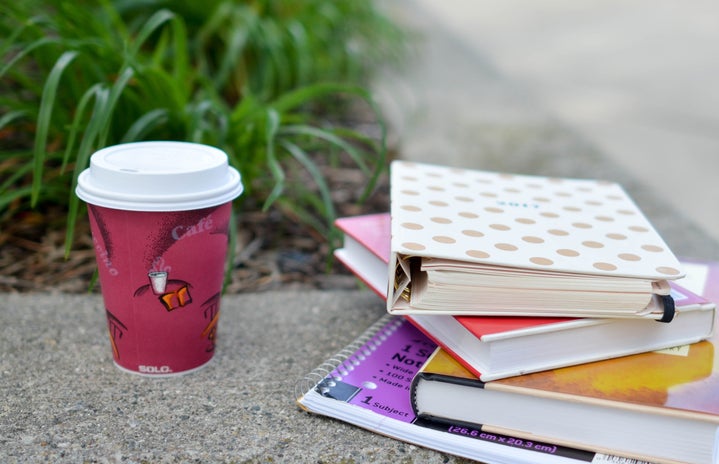It can be daunting to think about moving out of your house and into a college dorm room, let alone thinking about how to decorate the space. To lighten the stress of starting college (if that’s even possible), I decided to list a few tips for decorating your room that I’ve learned over the past three years. If you want a short check-list of tips, scroll to the bottom, but if you want detailed tips, keep reading!
Firstly, it is important to pick a color scheme with an accent color. This will make the room more cohesive, even if your roommate(s) don’t decorate in the same manner – which will, in turn, make it homier. I suggest picking colors that are common and won’t make it hard to get in all your belongings. Typically, more neutral tones are better for this. For example, my main colors are black, gray, and white. Then, the accent color is how you add that pop of color into the room. I picked my favorite color, blue, as my accent. If possible, it is nice to get everything in the same shade of whatever accent you pick, but it’s not necessary. Just avoid getting, for example, a light blue lamp and a dark blue bookcase.
When it comes to choosing what item to get in one color, I suggest having an idea of the layout of your room in mind already. That way, you won’t have three accent color items in a row and no accent colors elsewhere. Bedding is a great place to start with colors. I have a set that has a black and white pattern (with reversible sides so I can do mostly white, some black, or vise versa). It came with the comforter and a matching pillowcase. You can purchase sets that have matching sheets as well, but I picked out blue sheets with two blue pillowcases. And to even it out, I have a gray body pillow behind my three main pillows.
When actually in the room, the best way to open the space and make it more functional is to raise or loft the bed. At my school, it is an option to loft the bed to the height of a bunk bed without a bunk bed, which is what works best for me. But that may not be an option for every school. I suggest that if you can only raise your bed, to put it to the highest setting possible. You can store items like dressers, tubs, food, etc. there without it being obstructive to floor space.
With that, I highly recommend going to school with multiple sizes and styles of storage containers. They work well to keep your items organized and can also add into that color scheme to make the room cohesive. Tubs also hide items, making the space look cleaner without changing much.
The best advice for keeping yourself organized is to get a dry erase calendar for all your events, clubs, or important homework deadlines. It’s much easier to have everything visually in one space, rather than scattered in your brain.
When hanging items in your dorm room, ensure that you use only command strips. They will save you from ripping the paint off your walls when you move out of the space. The strips that work best for me are the Velcro ones since I can keep the one side of the Velcro on my items and only buy more the next year for the wall side. There are plenty kinds of command strips, including hooks both big and small. Find the ones that are best suited for what you’re hanging.
Contact paper and washi tape will also be very beneficial when decorating your room. They are small touches but can really make a difference. For example, Susquehanna has individual room air/heat units that are bulky and not the best looking. I hide the unit by covering it in mostly gray contact paper with small pieces of blue contact paper. It brightens up the room and conforms to the color scheme as well.
I highly suggest that you use as much wall space as possible (without overwhelming yourself) for organizational items, but also for personal items. In my room, I have a few cork boards and dry erase boards for different reasons. But also inspirational quotes/sayings and photos of friends and family. I also chose to hang my bags and purses on the wall not only for storage but also for the aesthetic they provide.
Don’t decorate your desk. This space is for studying and it needs to stay clear, or it may overwhelm you even more than your homework already does. I only have a lamp, a case for my pens and pencils, a photo, and a few small items. Keep all office items in the desk drawers.
And this wouldn’t be a “how-to” for decorating if I didn’t mention some plants. I love to keep succulents in my room because you can have so many different kinds of plants and pots. In my room, I have about 23 in total, but you don’t need to be that excessive. My first year, I started with only two small succulents and one aloe Vera plant. Plants aren’t necessary, but I love them so much that I always recommend them to everyone.
Lastly, having extra seating for friends is always nice. But dorm rooms are so small already that it can be so hard to find the space. Foldable seats are the best for this. I have a gray (notice the color scheme?) chair from Target that folds and easily stores in the cranny behind my storage containers. Plenty of stores offer these chairs in different colors and styles at pretty cheap rates.
Good luck with decorating your dorm room!
Ten Quick Steps to the Decorated Dorm Room
- Pick a color scheme with an accent color
- Raise or loft bed for more floor space
- Invest in storage containers
- Get a dry erase calendar
- Only use command strips – save money from damage billing
- Contact paper and washi tape are your best friends
- Use all the wall space possible – cork board, dry erase board, pictures
- Keep desk clear but still inviting – only a few things like a lamp, pen holder, picture frame
- Throw in a few plants for the aesthetic
- Keep extra, but easily storable, seating for your friends



